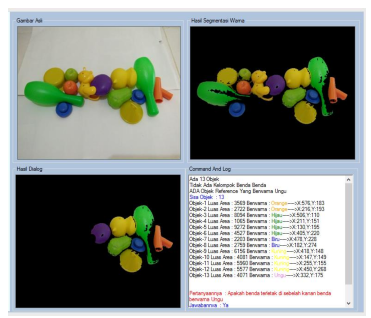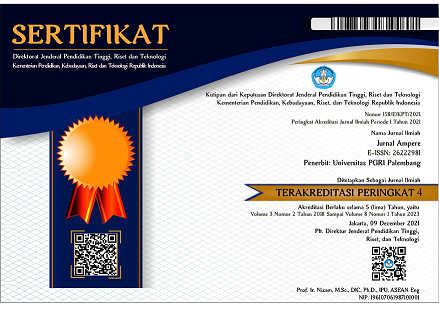Sistem Deteksi Objek Berbasis Pengolahan Citra Menggunakan Metode Diagram Venn
DOI:
https://doi.org/10.31851/ampere.v9i1.14778Keywords:
Pendeteksian Benda, Diagram Venn, Objek Terhalang, Pengolahan CitraAbstract
Penelitian ini bertujuan untuk mengembangkan sistem pendeteksian benda terhalang yang efektif dan efisien menggunakan metode diagram Venn. Sistem ini dirancang untuk membedakan objek yang terhalang dan terdistorsi, yang sulit dideteksi oleh komputer. Metode diagram Venn membagi situasi pendeteksian menjadi empat kategori berdasarkan kondisi objek acuan, warna dominan, dan posisi dominan. Sistem menghasilkan pertanyaan yang efektif dan efisien berdasarkan kategori tersebut, menghasilkan rata-rata 2 hingga 3 pertanyaan untuk mendeteksi objek, dibandingkan dengan 4 hingga 5 pertanyaan yang dibutuhkan manusia. Hasil penelitian menunjukkan bahwa sistem pendeteksian benda terhalang dengan diagram Venn lebih efektif dan efisien dibandingkan dengan metode manual. Sistem ini dapat membantu meningkatkan akurasi dan kecepatan deteksi objek dalam berbagai aplikasi, seperti pengenalan gambar, robotika, dan augmented reality.
References
Nurhadi, Silfaningrum.2008. Deteksi Obyek Berbasis Warna dan Ukuran Dengan Bantuan Interaksi Komputer-Manusia: Padang : Universitas Andalas.
Kurnia, Rahmadi. Dialog of Features Characteristics by Using Venn Diagram for Object Detection , Proc. ICMSA, 2009.
Kurnia, Rahmadi.2006.Generation of Efficient and User Friendly Queries for Helper Robots to Detect Target Object. Department of Information and Computer Sciences, Saitama University.
Lianyuan Jiang, Peihe Tang, Haohao Yuan, Chungui Li, and Yalan Zhang. “Fast Randomized Algorithm for Circle Detection by Efficient Sampling”. Journal of Theoretical and Applied Information Technology Vol.48 No.2. 20th february. (2013).
Jia Li-qin, Cheng-zhang Peng, Hong-min Liu, and Zhi-heng Wang. “A Fast Randomized Circle Detection Algorithm”. In Proc. 4th International Congress on Image Signal Processing IEEE (2011).
Rahadian, Asneli Putri. “Deteksi Lingkaran Pada Citra Benda Terhalang Menggunakan Metode Rumus Kelengkungan”. Padang : Universitas Andalas. (2015).
Tesi, Dwi Nafia. “Deteksi Lingkaran Pada Citra Benda Terhalang Menggunakan Metode Randomized Circle Detection (RCD)”. Padang : Universitas Andalas. (2015).
G. Damnati, F. Panaget, “ Adding NewWords in a Spoken DialogueSystem Vocavulary Using Conceptual Information and Derived Class-based LM”, Proceeding of Workshop on Automatic Speech Recognition and Understanding, 1999.
Masao Takizawa, Yasushi Makihara, Nobutaka Shimada, Jun Miura and Yoshiaki Shirai, “A Service Robot with Interactive Vision- Objects Recognition Using Dialog with User”. In Workshop on Language Understanding and Agents for Real World Interaction 2003.
Takuya Takahashi, Satoru Nakanishi, Yoshinori Kuno and Yoshiaki Shirai,”Human Robot Intervace by Verbal and Nonverbal Behaviors”. Conference: Intelligent Robots and Systems, 1998. Proceedings., 1998 IEEE/RSJ International Conference on, Volume: 2.
Yasushi Makihara , Masao Takizawa , Yoshiaki Shirai , Jun Miura , Nobutaka Shimada. “Object recognition supported by user interaction for service robots”. In 16th International Conference on Pattern Recognition, 2002. Proceedings.
Kurnia, Rahmadi. Deteksi Benda Berbasis Ciri Dengan Metode Dialog Komputer dan Manusia. Padang : Andalas University Press. 2015.
C. L. Chien and D. C. Tseng, “Color Image Enchancment with Exact Color Model”, International Journal of Innovatie Computing, Information and Control, Vol. 7, Number 12, Desember 2011, pp. 6691-6710.
H. D. Cheng, X. H. Jiang, Y Sun and Jingli Wang.”Color Image Segmentation : Advances and prospects” Pattern Recognition Department of Computer Science, Utah State University, Logan, UT 84322-4205, USA. Volume 34, Issue 12, December 2001, Pages 2259–2281.
Fatma, Mashiat and Jaya Sharma. “Leukemia Image Segmentation Using K-Means Clustering and HSI Color Image Segmentation”. In International Journal of Computer Applications (0975 – 8887) Volume 94 – No 12, May 2014.

Downloads
Published
How to Cite
Issue
Section
License
Copyright (c) 2024 Ratna Atika, Rahmadi Kurnia

This work is licensed under a Creative Commons Attribution-ShareAlike 4.0 International License.

Jurnal Ampere is licensed under a Creative Commons Attribution-ShareAlike 4.0 International License.
Authors who publish with this journal agree to the following terms:
- Authors retain copyright and grant the journal right of first publication with the work simultaneously licensed under a Creative Commons Attribution License that allows others to share the work with an acknowledgement of the work's authorship and initial publication in this journal.
- Authors are able to enter into separate, additional contractual arrangements for the non-exclusive distribution of the journal's published version of the work (e.g., post it to an institutional repository or publish it in a book), with an acknowledgement of its initial publication in this journal.
- Authors are permitted and encouraged to post their work online (e.g., in institutional repositories or on their website) prior to and during the submission process, as it can lead to productive exchanges, as well as earlier and greater citation of published work.





